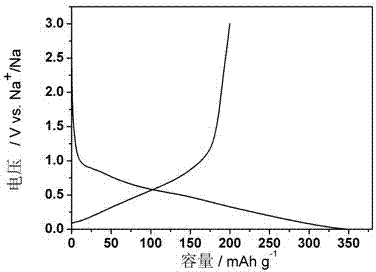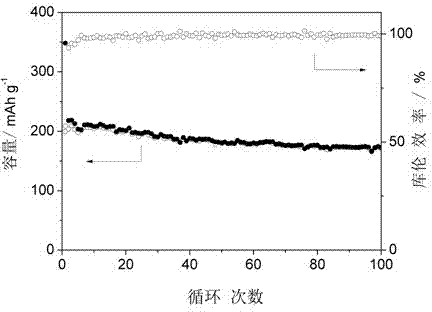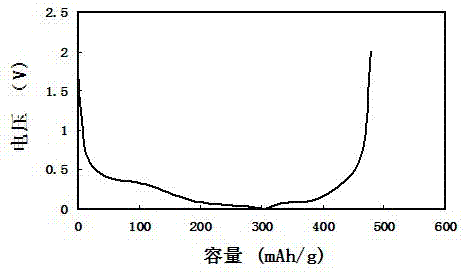Sodion battery cathode material
A sodium ion battery and negative electrode material technology, applied in battery electrodes, secondary batteries, circuits, etc., can solve the problems that sodium ions cannot be effectively intercalated and extracted, and sodium intercalated negative electrode materials are less
- Summary
- Abstract
- Description
- Claims
- Application Information
AI Technical Summary
Problems solved by technology
Method used
Image
Examples
Embodiment 1
[0017] Embodiment 1. Polyvinyl chloride pyrolytic carbon and electrochemical sodium storage performance
[0018] Place the polyvinyl chloride material in a high-temperature furnace filled with nitrogen, at 600 o C pyrolysis 6h. The obtained carbon material is uniformly mixed with vinylidene fluoride (PVDF) (dissolved in N-methylpyrrolidone) and acetylene black at a weight ratio of 90:5:5, and coated to form an electrode film. With the electrode film as the working electrode and the metal sodium sheet as the counter electrode, 1mol L -1 NaPF 6 (EC-DEC=1:1) Assembled the battery with the electrolyte to test its electrochemical performance, figure 1 The galvanostatic charge-discharge curve of polyvinyl chloride pyrolytic carbon. Such as figure 1 shown at 50 mA g -1 Under the current density, the reversible capacity of the material is 200mAh g -1 . After 100 cycles of battery cycling, 90% of the capacity is still maintained. ( figure 2 )
Embodiment 2
[0019] Example 2. Preparation and sodium storage performance of polythiophene pyrolytic carbon material
[0020] Place the polythiophene material in a high-temperature furnace filled with nitrogen, at 1200 o C pyrolysis for 10 hours, the obtained carbon material is mixed with vinylidene fluoride (PVDF) (dissolved in N-methylpyrrolidone) and acetylene black in a weight ratio of 90:5:5, and coated into an electrode film. With the electrode film as the working electrode and the metal sodium sheet as the counter electrode, 1mol L -1 NaPF 6 (EC-DEC=1:1) Assembled the battery with the electrolyte to test its electrochemical performance, image 3 It is the galvanostatic cycle performance curve of phenolic resin pyrolytic carbon, the current density is 50 mA g -1 , the charging and discharging voltage range is 2.0~0V (Na + / Na). Such as image 3 The material shown has a reversible capacity of 170mAh g -1 . Figure 4 is the cycle curve of the material. The capacity still main...
Embodiment 3
[0021] Embodiment 3. Preparation and sodium storage performance of polyaniline pyrolytic carbon
[0022] Place the polyaniline material in a high-temperature furnace filled with nitrogen, at 1000 o C pyrolysis for 6 hours, the obtained carbon material is mixed with vinylidene fluoride (PVDF) (dissolved in N-methylpyrrolidone) and acetylene black in a weight ratio of 90:5:5, and coated into an electrode film. With the electrode film as the working electrode and the metal sodium sheet as the counter electrode, 1mol L -1 NaPF 6 (EC-DEC=1:1) Assembled the battery with the electrolyte to test its electrochemical performance, the current density was 50 mA g -1 , the charging and discharging voltage range is 1.2~0V (Na + / Na). The tested material has a reversible capacity of 250 mAh g -1 , the capacity still maintains 220 mAh g after 100 cycles -1 .
PUM
 Login to View More
Login to View More Abstract
Description
Claims
Application Information
 Login to View More
Login to View More - R&D
- Intellectual Property
- Life Sciences
- Materials
- Tech Scout
- Unparalleled Data Quality
- Higher Quality Content
- 60% Fewer Hallucinations
Browse by: Latest US Patents, China's latest patents, Technical Efficacy Thesaurus, Application Domain, Technology Topic, Popular Technical Reports.
© 2025 PatSnap. All rights reserved.Legal|Privacy policy|Modern Slavery Act Transparency Statement|Sitemap|About US| Contact US: help@patsnap.com



